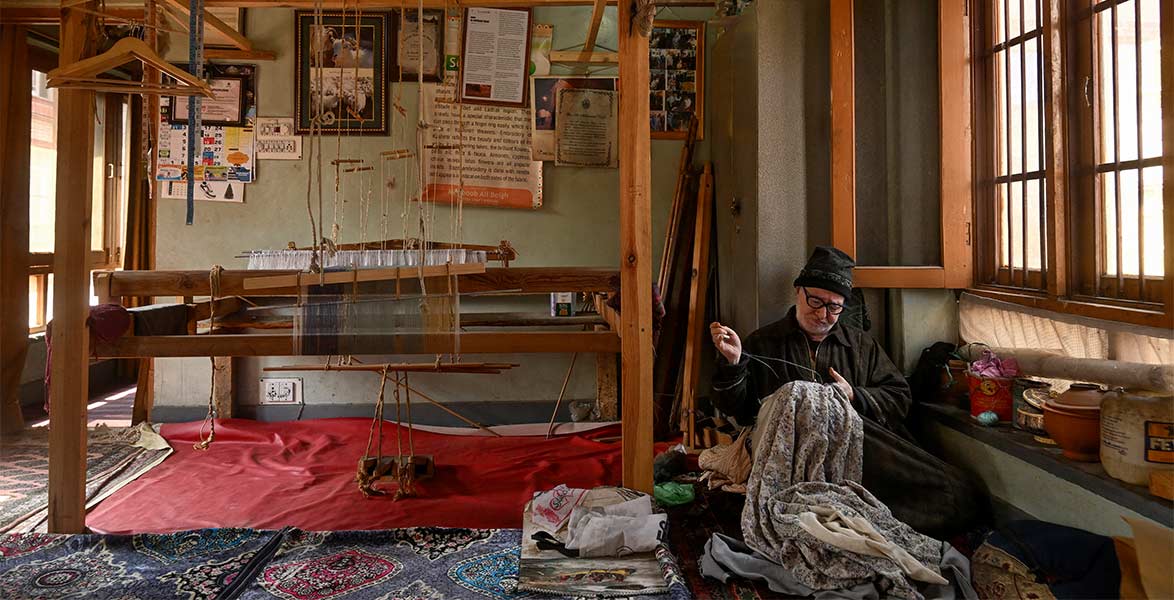Introduction: Kashmir’s Timeless Legacy in Crisis
Kashmir, long celebrated for its breathtaking landscapes and rich cultural tapestry, holds a special place in the world of traditional crafts. From the intricate artistry of Pashmina shawls to the vibrant beauty of Kani weaves and the delicate sophistication of papier-mâché, Kashmiri crafts have enchanted generations. Yet, beneath this legacy lies a struggle for survival. The journey from historical opulence to the current crossroads is fraught with challenges—political unrest, global competition, changing consumer trends, and the ever-present threat of fading traditions. As we step into 2025, the story of Kashmir’s crafts is not just about survival; it is about resilience, revival, and hope.
The Golden Threads of Kashmir’s Craft Heritage
For centuries, Kashmir has been the cradle of exquisite handwork. The region’s artisans, often working in family-run workshops, have passed their skills down through generations. These crafts include:
- Pashmina Shawls: Revered worldwide for their warmth, softness, and intricate embroidery.
- Kani Weaving: A labor-intensive technique that creates spectacular patterns using wooden spools.
- Sozni Embroidery: Detailed needlework that adorns garments and home textiles.
- Carpet Weaving: Famous for its Persian-inspired motifs and fine wool.
- Papier-mâché: Vibrant, hand-painted objects crafted from paper pulp.
These crafts have not only defined Kashmiri identity but also supported thousands of families, contributing significantly to the region’s economy.

Decades of Disruption: The Challenges Facing Kashmiri Artisans
Despite this rich tradition, the road for Kashmiri craftspeople has been anything but smooth. The past few decades have brought a storm of disruptions:
- Political Instability: Ongoing conflict and curfews have restricted movement, cut off markets, and disrupted supply chains.
- Pandemic Aftershocks: COVID-19 devastated sales, slashed tourism, and left artisans without buyers for months on end.
- Climate Change: Unpredictable weather patterns threaten the production of raw materials such as pashmina wool.
- Global Competition: Mass-produced imitations, especially from China, have flooded markets, often sold at a fraction of the cost.
- Changing Consumer Preferences: Younger generations are drawn to urban jobs and digital careers, leaving fewer hands to continue the craft.
These challenges have led to declining incomes, a shrinking workforce, and a real risk that some crafts could vanish entirely.


Survival Against the Odds: Stories from the Ground
Behind every shawl or handwoven carpet is a story of perseverance. Many artisans recount years when orders dried up and workshops fell silent. Yet, amid adversity, the spirit of innovation and adaptation has kept the crafts alive.
Some artisans have formed cooperatives, pooling resources to buy materials in bulk and sell finished goods directly to buyers. Others have embraced e-commerce, using social media to showcase their work and connect with a global audience. In rural areas, women’s self-help groups have emerged, reviving old embroidery techniques and empowering new generations.
Government and non-profit organizations have also stepped in with training programs, microloans, and platforms for artisans to exhibit their work. Such efforts have provided a lifeline, helping craftspeople adapt to new realities while preserving time-honored skills.
The Digital Turn: How Technology Is Reshaping Kashmir’s Crafts
As the world becomes more interconnected, digital technology has emerged as a double-edged sword for Kashmiri crafts. On one hand, online marketplaces offer unprecedented access to global customers. On the other, digital design tools and machine-made goods threaten to erode the uniqueness of handcraft.
However, many artisans are embracing the digital revolution. Instagram, Facebook, and dedicated e-commerce platforms are now vital tools for business. High-quality images and storytelling allow craftspeople to share not just products, but the cultural narratives behind them. Online workshops and virtual exhibitions are introducing Kashmiri crafts to younger, tech-savvy audiences, rekindling pride and interest in traditional skills.
In 2025, digital literacy among artisans is higher than ever. Many cooperatives offer training in online marketing, photography, and customer service. This digital turn is helping to bridge the gap between tradition and modernity, ensuring that Kashmir’s crafts remain relevant and visible on the world stage.
Authenticity in the Age of Imitation
One of the gravest threats to Kashmir’s crafts is the onslaught of cheap imitations. Machine-made “pashmina” shawls and synthetic carpets often bear labels that mislead customers. This not only hurts the credibility of genuine artisans but also devalues the labor-intensive processes behind authentic goods.
To combat this, the government and craft councils have introduced Geographical Indication (GI) tags and authenticity certificates. These measures help buyers distinguish real Kashmiri products and ensure that artisans receive fair compensation. In 2025, awareness campaigns and stricter regulations have helped to restore faith in the Kashmiri label, pushing back against the tide of counterfeits.
Women at the Heart of the Revival
Women have always played a crucial role in Kashmir’s craft economy. Today, their involvement is more visible and vital than ever. Many women-led collectives are reviving lost techniques, experimenting with contemporary designs, and gaining financial independence through craft.
These women are not only sustaining traditions but also driving social change. Through training and entrepreneurship, they are challenging stereotypes, supporting their families, and inspiring the next generation to value their heritage.

Looking Forward: Sustainability and the Future of Craft
As environmental awareness grows, sustainability has become a central concern for Kashmir’s artisans. Traditional methods are inherently eco-friendly: hand-spun pashmina, natural dyes, and minimal waste. In 2025, more craftspeople are adopting organic practices, using recycled materials, and promoting slow fashion.
International designers and ethical fashion brands are showing renewed interest in collaborating with Kashmiri artisans. Such partnerships bring not just income, but also recognition and respect for the skills that have shaped the region for centuries.

Conclusion: A Tapestry of Hope and Renewal
Kashmir’s crafts are more than just beautiful objects—they are the embodiment of a community’s resilience, creativity, and spirit. The journey to recovery is long and uncertain, but the signs of revival are unmistakable. Through innovation, collaboration, and a renewed appreciation for authenticity, Kashmiri artisans are weaving a new chapter for their timeless traditions.
As we move deeper into 2025, the world’s fashion and design communities have a unique opportunity—and responsibility—to support this revival. By choosing authentic, handcrafted goods and sharing the stories behind them, we can help ensure that the art of Kashmir not only survives, but thrives for generations to come.












